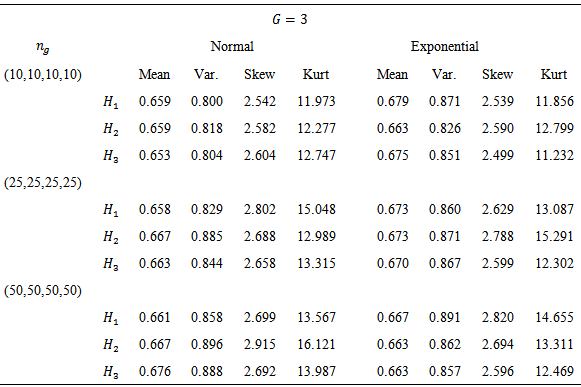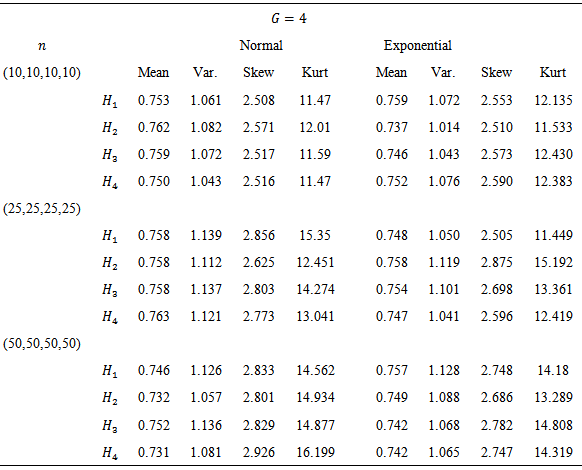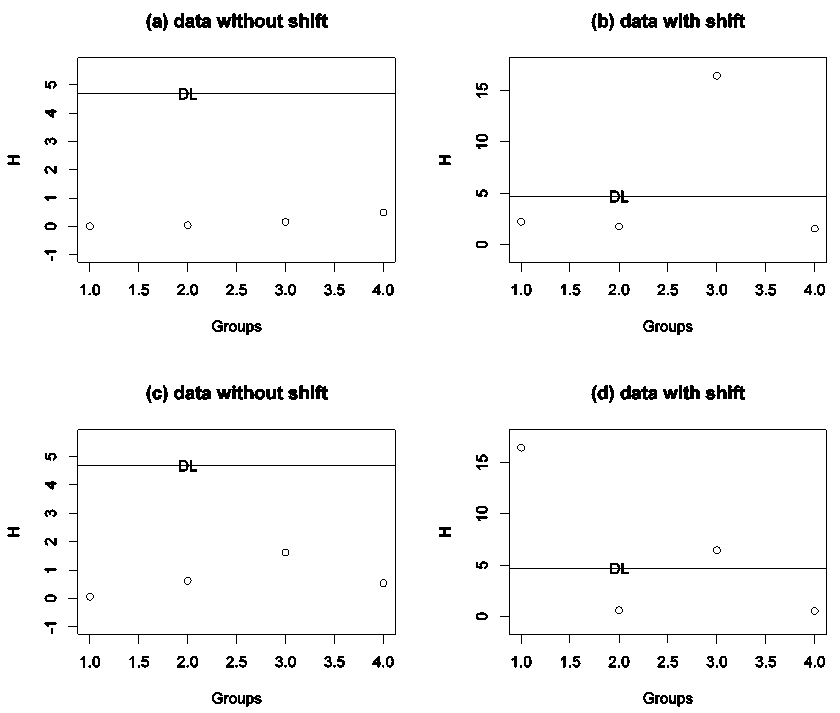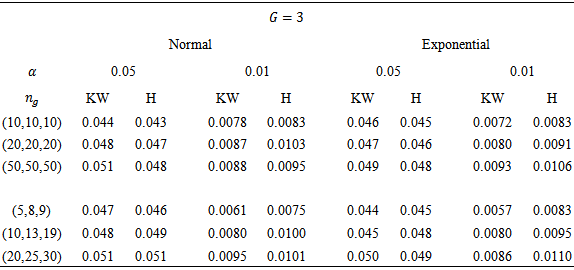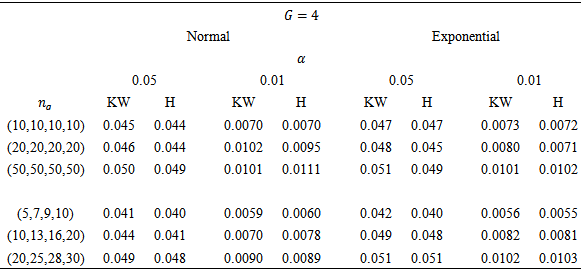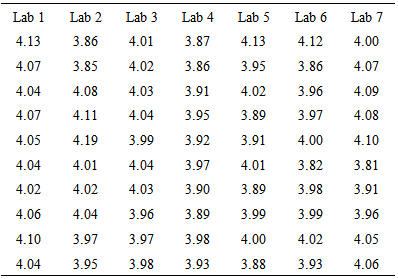-
Paper Information
- Previous Paper
- Paper Submission
-
Journal Information
- About This Journal
- Editorial Board
- Current Issue
- Archive
- Author Guidelines
- Contact Us
International Journal of Statistics and Applications
p-ISSN: 2168-5193 e-ISSN: 2168-5215
2015; 5(3): 113-119
doi:10.5923/j.statistics.20150503.03
Kruskal-Wallis Test: A Graphical Way
Elsayed A. H. Elamir
Department of Statistics and Mathematics, Benha University, Egypt & Management & Marketing Department, College of Business, University of Bahrain, Kingdom of Bahrain
Correspondence to: Elsayed A. H. Elamir, Department of Statistics and Mathematics, Benha University, Egypt & Management & Marketing Department, College of Business, University of Bahrain, Kingdom of Bahrain.
| Email: |  |
Copyright © 2015 Scientific & Academic Publishing. All Rights Reserved.
The Kruskal-Wallis is a non-parametric method for testing whether samples originate from the same distribution. When the null hypothesis is rejected, at least one sample stochastically dominates at least one other sample. The test does not identify where this stochastic dominance occurs. Consequently, a decision limit for Kruskal-Wallis test is derived based on the gamma distribution and Bonferonni approximation that shows graphically where this stochastic dominance occurs. Simulation studies confirm the validity and robustness of the decision limit in small and large samples. An application is given to illustrate the method.
Keywords: Bonferonni approximation, Chi square distribution, Gamma distribution, Nonparametric tests
Cite this paper: Elsayed A. H. Elamir, Kruskal-Wallis Test: A Graphical Way, International Journal of Statistics and Applications, Vol. 5 No. 3, 2015, pp. 113-119. doi: 10.5923/j.statistics.20150503.03.
Article Outline
1. Introduction
- Kruskal and Wallis (1952) introduced a rank-based test for comparison of several medians or means, complementing the parametric approaches. Kruskal-Wallis (KW) test is to be among the most useful of available hypothesis testing procedures for behavioural and social research, though it is also one of the many under-utilized nonparametric procedures. Parametric methods, along with the requirement for a stronger set of assumptions, continue to dominate the research landscape despite convincing studies that call into question the wisdom of making such assumptions; see, [2], and [3]. Replacing original scores with ranks does not inherently lead to lower power, as one might suppose, but rather can result in a power increase at best and a slight power loss, at worst; see, for example, [4], [5], [6], [7] and [8].Kruskal and Wallis [1] said that “...One of the most important applications of the test is in detecting differences among the population means” (p.584). Also they suggested that “… in practice the H test may be fairly insensitive to differences in variability, and so may be useful in the important ‘Behrens-Fisher problem’ of comparing means without assuming equality of variances” (p.599). Furthermore, Iman [9] formulated the null hypothesis of Kurskal-Wallis test in terms of the expected values (p. 726).When the null hypothesis is rejected, at least one sample stochastically dominates at least another one. The KW test does not identify where this stochastic dominance occurs. Therefore, the Kruskal-Wallis test is rewritten in the form of the sum of independent chi square random variables. Using the idea of Bonferonni approximation, a decision limit for Kruskal-Wallis test is obtained based on the gamma distribution that shows graphically which groups out of the decision limit. A simulation study is conducted using the normal and exponential distributions to confirm the validity and robustness of the decision limit in small and large samples for the new method in comparison with KW test.The graphical presentation of the KW test is introduced in Section 2. Simulation results to compare between the KW test and the new method are given in Section 3. An application is presented in Section 4. Section 5 is devoted for conclusion.
2. Graphical Presentation of Kruskal-Wallis Test
- Suppose independent random observations
 are obtained from a continuous population with mean
are obtained from a continuous population with mean  and variance
and variance  is the number of groups or treatments and
is the number of groups or treatments and  is the sample size in each group. The model is
is the sample size in each group. The model is 
 is the global location of the data,
is the global location of the data,  the difference to the location of the
the difference to the location of the  group and
group and  is the residual error; see, for example, [2]. Thus the null hypothesis can be expressed as
is the residual error; see, for example, [2]. Thus the null hypothesis can be expressed as versus at least two medians or means are not equal.
versus at least two medians or means are not equal.2.1. Kruskal-Wallis test
- The ranks of the observations
 are
are The Kruskal-Wallis test is defined as
The Kruskal-Wallis test is defined as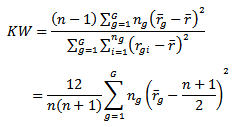 where
where  and
and  and it is assumed that the ties are handled by random method.This is distributed as
and it is assumed that the ties are handled by random method.This is distributed as  See, [10] and [1] and [11]. Also,
See, [10] and [1] and [11]. Also,  can be written as
can be written as 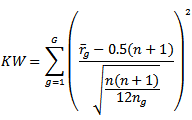 The contribution of each standardized group mean rank in the test is defined as
The contribution of each standardized group mean rank in the test is defined as 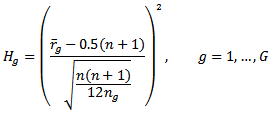 Therefore, the Kruskal-Wallis test could be plotted as
Therefore, the Kruskal-Wallis test could be plotted as This is called H-graph. To do this the sampling distribution of
This is called H-graph. To do this the sampling distribution of  is needed. The first thinking is gamma distribution where [1] used in small sample sizes and the chi square is a special case from it.
is needed. The first thinking is gamma distribution where [1] used in small sample sizes and the chi square is a special case from it. 2.2. Sampling Distribution of 
- To investigate if the sampling distribution of
 is a gamma distribution or not, a simulation study is conducted to obtain the first four moments of
is a gamma distribution or not, a simulation study is conducted to obtain the first four moments of  for
for  and
and  using simulated data from normal and exponential distributions with different sample sizes. Three sets of data are investigated (a) small
using simulated data from normal and exponential distributions with different sample sizes. Three sets of data are investigated (a) small  (b) medium
(b) medium  and large
and large  The following steps are used in simulation:1. Simulate data from a distribution with the same mean for the required design.2. Rank the combined sample, compute
The following steps are used in simulation:1. Simulate data from a distribution with the same mean for the required design.2. Rank the combined sample, compute  for each group and moments for each
for each group and moments for each  3. Repeat this
3. Repeat this  times and compute average for each moments.Tables 1 and 2 gives the moments of
times and compute average for each moments.Tables 1 and 2 gives the moments of  for
for  and
and  From Tables 1 and 2 it can conclude that
From Tables 1 and 2 it can conclude that 
|
|
- Therefore the chi square distribution with one degree of freedom does not fit
 for small
for small  The gamma distribution is used to fit the sampling distribution of
The gamma distribution is used to fit the sampling distribution of  by matching the first two moments; see, [1]. Since the first two moments for gamma distribution are
by matching the first two moments; see, [1]. Since the first two moments for gamma distribution are where
where  is the shape and
is the shape and  is the scale. Therefore,
is the scale. Therefore, Using the shape and the
Using the shape and the  parametrization then
parametrization then It is clear that for large
It is clear that for large  the sampling distribution of
the sampling distribution of  approaches chi square distribution with one degree of freedom.
approaches chi square distribution with one degree of freedom.2.3. Graphical Presentation
- The Kruskal-Wallis test is plotted as
 If any point outside the decision limit,
If any point outside the decision limit,  is rejected and this will identify where stochastic dominance occurs.Since the test is written as sum of independent chi square random variables
is rejected and this will identify where stochastic dominance occurs.Since the test is written as sum of independent chi square random variables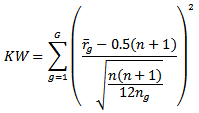 and each term has almost the same distribution. Rather than working with whole distribution, it can do the test based on
and each term has almost the same distribution. Rather than working with whole distribution, it can do the test based on with adjusted
with adjusted  using Bonferonni approximation. The advantage of this (a) it can tell which group is out of the limit (b) it can easily be used to compute the effect size.To find the decision limit for
using Bonferonni approximation. The advantage of this (a) it can tell which group is out of the limit (b) it can easily be used to compute the effect size.To find the decision limit for  there are multiple tests
there are multiple tests  and it is needed to distinguish between two meanings of
and it is needed to distinguish between two meanings of  when performing multiple tests:1. The probability of making a Type I error when dealing only with a specific test. This probability is denoted
when performing multiple tests:1. The probability of making a Type I error when dealing only with a specific test. This probability is denoted  (“alpha per test"). It is also called the test-wise alpha.2. The probability of making at least one Type I error for the whole family of tests. This probability is denoted
(“alpha per test"). It is also called the test-wise alpha.2. The probability of making at least one Type I error for the whole family of tests. This probability is denoted  (“alpha per family of tests”). It is also called the family-wise or the experiment-wise alpha. The probability of making at least one Type I error for a family of
(“alpha per family of tests”). It is also called the family-wise or the experiment-wise alpha. The probability of making at least one Type I error for a family of  tests is
tests is This equation can be rewritten as
This equation can be rewritten as For more details; see, for example, [12] and [13]. A simpler approximation which is known as the Bonferonni approximation is
For more details; see, for example, [12] and [13]. A simpler approximation which is known as the Bonferonni approximation is  For example, to perform
For example, to perform  and the risk of making at least one Type I error to an overall value of
and the risk of making at least one Type I error to an overall value of  with the Bonferonni approximation, a test reaches significance if its associated probability is smaller than
with the Bonferonni approximation, a test reaches significance if its associated probability is smaller than By using the quantile function of gamma distribution (for example, R-software), the decision limit is
By using the quantile function of gamma distribution (for example, R-software), the decision limit is Therefore,
Therefore,
 is rejected. Note that this technique is related to analysis of means; see, for example, [14], [15] and [16].Figure 1 shows the graphical presentation of Kurskal-Wallis test for simulated data from normal and exponential distributions using
is rejected. Note that this technique is related to analysis of means; see, for example, [14], [15] and [16].Figure 1 shows the graphical presentation of Kurskal-Wallis test for simulated data from normal and exponential distributions using  and total sample sizes 40.Figures 1 (a) and (c) show the H graph for data simulated from normal and exponential distributions with no shift in mean and it clear that no points outside the decision limit while Figures 1 (b) and (d) show the H graph for data simulated from normal and exponential distributions with shift in mean and is clear that there are points outside the decision limit.
and total sample sizes 40.Figures 1 (a) and (c) show the H graph for data simulated from normal and exponential distributions with no shift in mean and it clear that no points outside the decision limit while Figures 1 (b) and (d) show the H graph for data simulated from normal and exponential distributions with shift in mean and is clear that there are points outside the decision limit.3. Comparisons
- The new method is compared with KW test in terms of Type I error. Two variables were manipulated in the study: (a) number of groups (3 and 4) and (b) sample size (small-medium-large). For each design size, three sample size cases were investigated. In our designs, the smallest of the three cases investigated for each design has an average group size of less than 10, the middle has an average group size less than 20 while the larger case in each design had an average group size less than 30. With respect to the effects of distributional shape on Type I error, the normal and exponential distributions were selected. To evaluate the particular conditions under which a test was insensitive to assumption violations, the idea of [17] of robustness criterion was employed. According to this criterion, in order for a test to be considered robust, its empirical rate of Type I error
 must be contained in the interval
must be contained in the interval  The choice of Bradley was
The choice of Bradley was  and this makes the interval is liberal. Therefore, in this study the choice of
and this makes the interval is liberal. Therefore, in this study the choice of  a something in the middle between nothing and 0.025. Therefore, for the five percent level of significance, a test was considered robust in a particular condition if its empirical rate of Type I error fell within the interval
a something in the middle between nothing and 0.025. Therefore, for the five percent level of significance, a test was considered robust in a particular condition if its empirical rate of Type I error fell within the interval  and for the one percent level of significance the choice of
and for the one percent level of significance the choice of  a test was considered robust if its empirical rate of Type I error fell within the interval
a test was considered robust if its empirical rate of Type I error fell within the interval  . Correspondingly, a test was considered to be nonrobust if, for a particular condition, its Type I error rate was not contained in these intervals. Nonetheless, there is no one universal standard by which tests are judged to be robust, so different interpretations of the results are possible.Tables 3 and 4 contain empirical rates of Type I error for a design containing three and four groups, respectively. The tabled data indicates that 1. When the observations were obtained from normal distributions, rates of Type I error were controlled by KW and H methods for equal and non equal sample sizes.2. When the observations were obtained from non-normal distributions, rates of Type I error were controlled by KW and H methods for equal and non equal sample sizes.
. Correspondingly, a test was considered to be nonrobust if, for a particular condition, its Type I error rate was not contained in these intervals. Nonetheless, there is no one universal standard by which tests are judged to be robust, so different interpretations of the results are possible.Tables 3 and 4 contain empirical rates of Type I error for a design containing three and four groups, respectively. The tabled data indicates that 1. When the observations were obtained from normal distributions, rates of Type I error were controlled by KW and H methods for equal and non equal sample sizes.2. When the observations were obtained from non-normal distributions, rates of Type I error were controlled by KW and H methods for equal and non equal sample sizes.
|
|
4. Application
- From [18] a study of the use of a semi automated method for measuring the amount of chlopheniramine maleate in tablets, for each of four manufacturers, composites were prepared by grinding and mixing together tablets that had nominal dosage levels of 4 mg. Seven labs were asked to make 10 determinations on each composite; each determination was made on a portion of composite whose weight was equivalent to that of one tablet. The purpose of the experiment: are the differences in the means or medians of the measurement from the various labs significant, or might they be due to chances?Table 5 gives the amount of chlopheniramine maleate in tablets for seven labs.
|
 This indicates that there is a systematic difference among the labs at 0.05 and 0.01 level of significance without telling anything about the differences. While H-graph in Figure 2 shows that there are two points outside the decision limit that indicates there is a systematic difference among the labs at 0.05 and 0.01 level of significance. Moreover identify the labs 1 and 4 as different from the overall mean.
This indicates that there is a systematic difference among the labs at 0.05 and 0.01 level of significance without telling anything about the differences. While H-graph in Figure 2 shows that there are two points outside the decision limit that indicates there is a systematic difference among the labs at 0.05 and 0.01 level of significance. Moreover identify the labs 1 and 4 as different from the overall mean.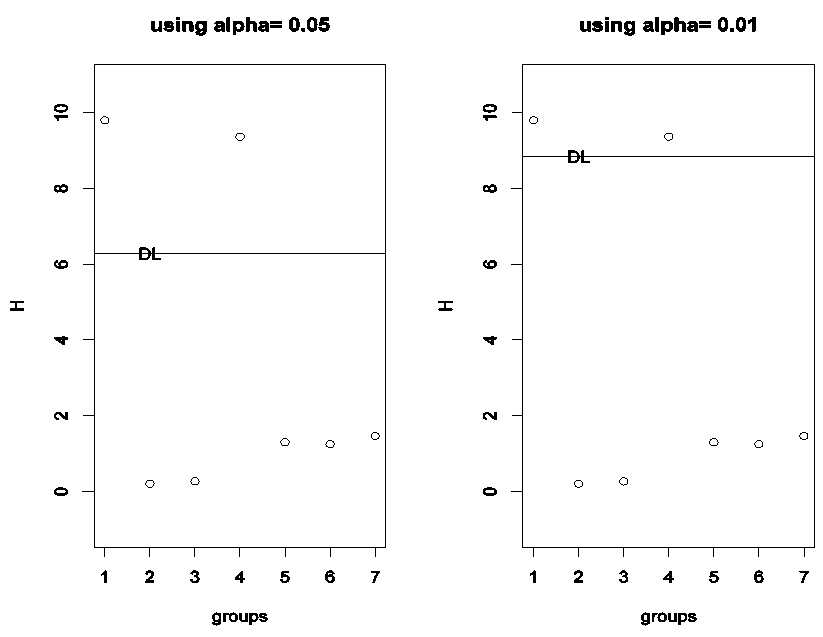 | Figure 2. H-graph for the amount of chlopheniramine maleate in tablet data |
5. Conclusions
- A graphical presentation of Kruskal Wallis test is studied by re-expressing the test as sum of independent chi square random variables. The sampling distribution for this function was obtained and found that the gamma distribution had given a very good fit for this function until for small sample sizes.A decision limit is obtained using the gamma distribution and Bonferonni approximation that enabled us to show Kruskal-Wallis test graphically. The main advantage of the new method is not only provided us about the differences in medians or means but also where these differences had been happened. Moreover, a simulation study confirmed the validity and robustness of the decision limit in small and large samples in comparison with Kruskal Wallis test.
 Abstract
Abstract Reference
Reference Full-Text PDF
Full-Text PDF Full-text HTML
Full-text HTML